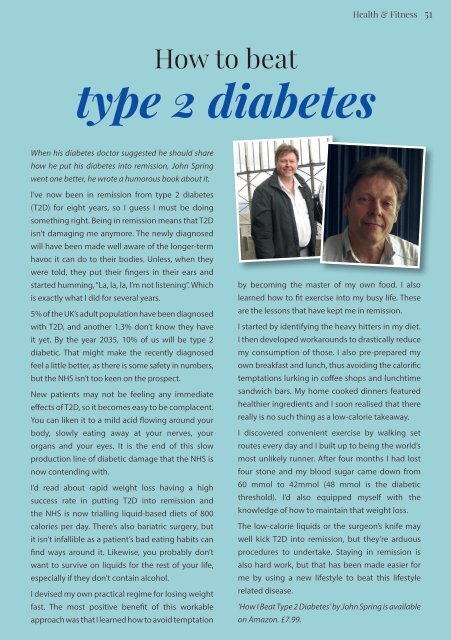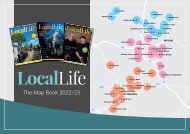You also want an ePaper? Increase the reach of your titles
YUMPU automatically turns print PDFs into web optimized ePapers that Google loves.
Health & Fitness<br />
51<br />
How to beat<br />
type 2 diabetes<br />
When his diabetes doctor suggested he should share<br />
how he put his diabetes into remission, John Spring<br />
went one better, he wrote a humorous book about it.<br />
I’ve now been in remission from type 2 diabetes<br />
(T2D) for eight years, so I guess I must be doing<br />
something right. Being in remission means that T2D<br />
isn’t damaging me anymore. The newly diagnosed<br />
will have been made well aware of the longer-term<br />
havoc it can do to their bodies. Unless, when they<br />
were told, they put their fingers in their ears and<br />
started humming, “La, la, la, I’m not listening”. Which<br />
is exactly what I did for several years.<br />
5% of the UK’s adult population have been diagnosed<br />
with T2D, and another 1.3% don’t know they have<br />
it yet. By the year 2035, 10% of us will be type 2<br />
diabetic. That might make the recently diagnosed<br />
feel a little better, as there is some safety in numbers,<br />
but the NHS isn’t too keen on the prospect.<br />
New patients may not be feeling any immediate<br />
effects of T2D, so it becomes easy to be complacent.<br />
You can liken it to a mild acid flowing around your<br />
body, slowly eating away at your nerves, your<br />
organs and your eyes. It is the end of this slow<br />
production line of diabetic damage that the NHS is<br />
now contending with.<br />
I’d read about rapid weight loss having a high<br />
success rate in putting T2D into remission and<br />
the NHS is now trialling liquid-based diets of 800<br />
calories per day. There’s also bariatric surgery, but<br />
it isn’t infallible as a patient’s bad eating habits can<br />
find ways around it. Likewise, you probably don’t<br />
want to survive on liquids for the rest of your life,<br />
especially if they don’t contain alcohol.<br />
I devised my own practical regime for losing weight<br />
fast. The most positive benefit of this workable<br />
approach was that I learned how to avoid temptation<br />
by becoming the master of my own food. I also<br />
learned how to fit exercise into my busy life. These<br />
are the lessons that have kept me in remission.<br />
I started by identifying the heavy hitters in my diet.<br />
I then developed workarounds to drastically reduce<br />
my consumption of those. I also pre-prepared my<br />
own breakfast and lunch, thus avoiding the calorific<br />
temptations lurking in coffee shops and lunchtime<br />
sandwich bars. My home cooked dinners featured<br />
healthier ingredients and I soon realised that there<br />
really is no such thing as a low-calorie takeaway.<br />
I discovered convenient exercise by walking set<br />
routes every day and I built up to being the world’s<br />
most unlikely runner. After four months I had lost<br />
four stone and my blood sugar came down from<br />
60 mmol to 42mmol (48 mmol is the diabetic<br />
threshold). I’d also equipped myself with the<br />
knowledge of how to maintain that weight loss.<br />
The low-calorie liquids or the surgeon’s knife may<br />
well kick T2D into remission, but they’re arduous<br />
procedures to undertake. <strong>St</strong>aying in remission is<br />
also hard work, but that has been made easier for<br />
me by using a new lifestyle to beat this lifestyle<br />
related disease.<br />
‘How I Beat Type 2 Diabetes’ by John Spring is available<br />
on Amazon. £7.99.


















